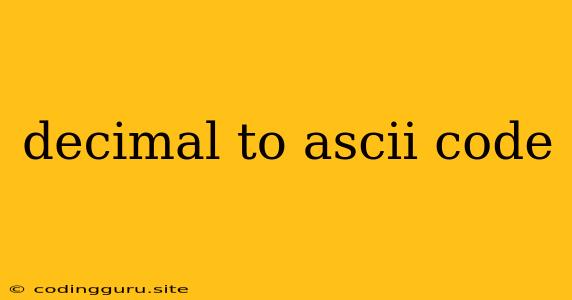Converting Decimal to ASCII Code: A Simple Guide
Have you ever encountered a scenario where you need to convert a decimal number into its corresponding ASCII character? Perhaps you're working with data transmission, parsing text files, or simply exploring the fascinating world of character encoding. Whatever the reason, converting decimal numbers to ASCII is a valuable skill to possess.
This article will guide you through the process, providing a clear understanding of the concept, practical examples, and potential applications.
What is ASCII?
ASCII, standing for American Standard Code for Information Interchange, is a character encoding standard that assigns unique numerical values to various characters, including letters, numbers, punctuation marks, and control characters. Each character is represented by a 7-bit binary code, ranging from 0 to 127. This means there are 128 distinct characters that can be represented using ASCII.
Understanding Decimal to ASCII Conversion
Converting a decimal number to its ASCII equivalent involves understanding the mapping between decimal values and ASCII characters. The process is straightforward:
- Identify the Decimal Value: You start with the decimal number representing the desired character.
- Find the Corresponding ASCII Character: Consult an ASCII table (easily found online) to locate the character associated with the given decimal value.
Practical Examples
Let's illustrate the conversion process with some examples:
- Decimal 65: Looking at an ASCII table, we find that decimal 65 corresponds to the uppercase letter "A".
- Decimal 97: Similarly, decimal 97 maps to the lowercase letter "a".
- Decimal 32: This decimal value represents a space character.
How to Convert Decimal to ASCII Code
Several methods can be employed to convert decimal numbers to ASCII characters, depending on your preferred programming language or environment. Let's explore some common approaches:
1. Using Online Converters: Numerous online tools are available that perform decimal to ASCII conversions instantly. You simply input the decimal number, and the converter displays the corresponding ASCII character.
2. Utilizing Programming Languages: Most programming languages offer built-in functions or libraries for character encoding. Here are some examples:
-
Python: The
chr()function takes an integer as input and returns the corresponding ASCII character.decimal = 65 ascii_character = chr(decimal) print(ascii_character) # Output: A -
JavaScript: Similar to Python, the
String.fromCharCode()method converts a decimal number to its ASCII equivalent.decimal = 97; ascii_character = String.fromCharCode(decimal); console.log(ascii_character); // Output: a
3. Manual Calculation: While not the most practical method, understanding the underlying process can be beneficial. You can convert a decimal number to its binary representation using the standard conversion method. Then, you would need to check the ASCII table to identify the character corresponding to that binary code.
Applications of Decimal to ASCII Conversion
Converting decimal numbers to ASCII characters finds practical applications in various domains:
- Data Transmission: When data is transmitted across networks, it is often encoded using ASCII. Converting decimal values to their ASCII equivalents ensures the accurate transmission of characters.
- Text File Parsing: Text files often store data in ASCII format. Understanding decimal to ASCII conversion is essential for correctly parsing and processing text files.
- Security and Cryptography: ASCII characters are crucial in security and cryptography. For instance, converting decimal numbers to ASCII is a fundamental step in encoding passwords and other sensitive information.
- Game Development: ASCII characters are used in game development for displaying text and graphics.
- Command Line Interfaces: Many command-line tools and operating systems rely on ASCII for input and output.
Beyond ASCII: Extended ASCII
While standard ASCII covers 128 characters, extended ASCII offers an extended set of characters, including accented letters, symbols, and special characters. It uses an 8-bit code, allowing for 256 possible characters.
Conclusion
Converting decimal numbers to ASCII characters is a fundamental concept in computer science and data processing. Understanding this conversion process allows you to effectively work with character encoding, interpret data correctly, and explore the fascinating world of text representation. Whether you're developing software, parsing data, or simply curious about how characters are represented, a solid grasp of decimal to ASCII conversion will prove valuable.
